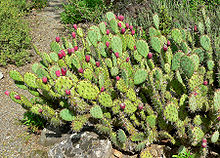
Back Opuntia Afrikaans صبير Arabic صبير (جنس من النباتات) ARZ Opuntia AST Апунцыя Byelorussian Апунцыя BE-X-OLD Опунция Bulgarian ফণী-মনসা (দ্ব্যর্থতা নিরসন) Bengali/Bangla Opuntia Catalan Opuntia CEB
| Opuntia | |
|---|---|

| |
| O. littoralis var. vaseyi | |
| Scientific classification | |
| Kingdom: | Plantae |
| Clade: | Tracheophytes |
| Clade: | Angiosperms |
| Clade: | Eudicots |
| Order: | Caryophyllales |
| Family: | Cactaceae |
| Subfamily: | Opuntioideae |
| Tribe: | Opuntieae |
| Genus: | Opuntia Mill. |
| Species | |
|
Many, see List of Opuntia species. | |
| Synonyms | |
and see text | |
Opuntia, commonly called the prickly pear cactus, is a genus of flowering plants in the cactus family Cactaceae, many known for their flavorful fruit and showy flowers.[1] Cacti are well-adapted to aridity; however, they are still vulnerable to alterations in precipitation and temperature driven by climate change.[2] Prickly pear alone is more commonly used to refer exclusively to the fruit, but may also be used for the plant itself; in addition, other names given to the plant and its specific parts include tuna (fruit), sabra, sabbar, nopal (pads, plural nopales) from the Nahuatl word nōpalli, nostle (fruit) from the Nahuatl word nōchtli, and paddle cactus. The genus is named for the Ancient Greek city of Opus,[3] where, according to Theophrastus, an edible plant grew and could be propagated by rooting its leaves.[failed verification] The most common culinary species is the "Barbary fig" (Opuntia ficus-indica).
- ^ "Opuntia ficus-indica (prickly pear)". CABI. 3 January 2018. Retrieved 23 May 2018.
- ^ Albuquerque, Fabio; Benito, Blas; Rodriguez, Miguel Ángel Macias; Gray, Caitlin (19 September 2018). "Potential changes in the distribution of Carnegiea gigantea under future scenarios". PeerJ. 6: e5623. doi:10.7717/peerj.5623. ISSN 2167-8359. PMC 6151114. PMID 30258720.
- ^ Quattrocchi, Umberto (2000). CRC World Dictionary of Plant Names. Vol. III M-Q. CRC Press. p. 1885. ISBN 978-0-8493-2677-6.